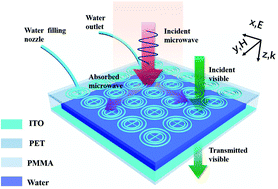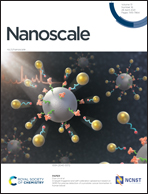Tunable and transparent broadband metamaterial absorber with water-based substrate for optical window applications†
Abstract
A tunable and transparent metamaterial absorber (MMA) with a water-based substrate is presented, with high optical transparency and broadband microwave absorptivity. In the material structure, indium–tin–oxide (ITO) films are included as the resonant pattern and reflective layers, and distilled water is combined with polymethyl methacrylate (PMMA) to produce the dielectric substrate. By effectively designing its structural parameters, the proposed absorber achieves >90% absorptivity, covering an ultrawide frequency range of 5.8–16.2 GHz, while the average optical transmittance is ∼70.18% over a wavelength range of 400–800 nm. Moreover, owing to a specific design feature, the absorber has high polarization insensitivity and wide-incident-angle stability for transverse electric (TE) and transverse magnetic (TM) polarization waves. Furthermore, the absorption properties of the absorber can be further tuned by controlling the thickness of the water substrate. Both numerical simulations and experimental measurements demonstrate the excellent performance of the device, showing its strong potential for use in optical windows within military and medical equipment.



 Please wait while we load your content...
Please wait while we load your content...